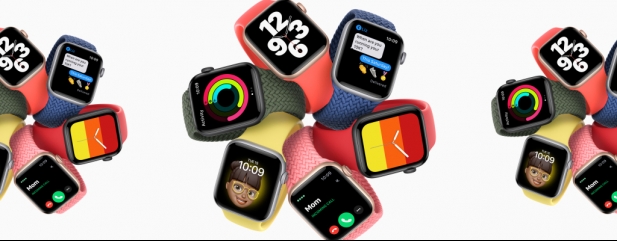Archived article
Please note that tax, investment, pension and ISA rules can change and the information and any views contained in this article may now be inaccurate.
$2 trillion Apple is worth its premium price tag

California-based Apple is the most valuable company in the world, worth just shy of $2 trillion. It has been generating fantastic returns for investors for a long time and it enjoys a very loyal customer base. A £5,000 investment 10 years ago would today be worth £61,180 if you had reinvested all dividends.
It’s fair to say that 2020 has been another knockout year for Apple despite the Covid-19 outbreak, with a 56% share price gain year to date. Apple has comfortably outstripped the tech heavy Nasdaq Composite’s 26% gain this year and smashed the widely tracked S&P 500 index’s 5% advance.
But since the start of September the Apple share price has stalled, falling from record $134.18 highs to now trade at $116.87. With that pullback in mind many investors will be wondering if Apple shares are a buy right now. We think they are.
MAKING APPLE TICK
The Apple investment story is easy to understand. Customers buy a device, get hooked into Apple’s services ecosystem and keep coming back for more. In a December 2018 survey by Kantar, 90% of US iPhone users said they planned to remain loyal to future Apple devices.
Apple now has more than 550 million paid subscribers across its services portfolio. The company expects to reach its 600 million paid subscribers target before the end of calendar 2020.
Co-founder Steve Jobs returned to run Apple in 1997 and oversaw a winning streak of innovations that included the iMac, iPod, iTunes, iPhone, iPad and the App Store.
The biggest driver of Apple’s modern success is the iPhone, a game-changing smartphone that has sold well over 2.2 billion units since its launch in 2007, although we can’t get exact numbers since the company stopped making unit sales volumes public a few years ago.
That decision was controversial, and some fund managers complained that it was a regressive move from a corporate transparency perspective. Some sceptics also wondered if it had been designed to disguise a long-term slowing of iPhone sales growth as users hold on to their handsets for longer between upgrades.
In the first three quarters of the financial year ending 30 September 2020, iPhone revenue growth totalled 8% in the first three months, -7% in the second quarter, followed by 1.9% growth in the three months to 30 June. That’s disappointing (although you have to take Covid-19 into consideration) but Apple could be on the brink of a major upgrade cycle with its first 5G iPhones which launched on 23 October.
SUPERFAST 5G READY
The 5G-enabled family of iPhone 12s include 5.4-inch, 6.1-inch and 6.7-inch displays and starting prices ranging from $699 to $1,099 (or the equivalent in pounds for UK buyers). The iPhone 12 is thinner, smaller and lighter than the iPhone 11. The base iPhone 12 is also $100 more than its iPhone 11 equivalent, an important measure in assessing upsell potential from its loyal users.
The four handsets launched feature a new design, a variety of changes to the camera on the rear, more processing power, among other features. The top of the range Pro models have even more extras, including a new rear-facing LiDAR scanner which uses depth sensing for photo and video applications, including faster autofocus in low light situations. It opens up new possibilities for augmented-reality experiences.
Apple has also introduced the HomePod Mini smart speaker that should give Apple better competitive footing against market leaders Amazon and Google.
OPPORTUNITIES FOR GROWTH
If iPhone growth continues to slow investors should look to two other revenues streams to give sales and profits a boost: services and wearables. These are the main reasons why Apple’s share price enjoyed such a strong run earlier this year as the market started to appreciate there is still massive potential for the company to boost earnings for years to come.
In the June quarter, Apple’s services revenue rose 15% to $13.2 billion, continuing a long-run trend. Services include the App Store, AppleCare (insurance), iCloud (data storage), Apple Pay, Apple Music, Apple TV+ and Apple Arcade (gaming).
To make it easier for users to access more services the company has now introduced a subscription bundle called Apple One, putting it on the right track to rapidly grow reliable and predictable subscription income and become less hooked on device sales.
The idea behind Apple One is to leverage its most popular Apple Music and iCloud engines to drive higher take-up of newer and lesser used services. For example, a current Apple Music ($10 monthly) and Apple TV+ subscriber ($5 monthly) with 50 Gigabytes of iCloud storage ($1 monthly) would collectively be paying $16 a month, with each one billed separately.
The basic Apple One package ($15 monthly) includes all three services plus Apple Arcade gaming. This makes it a no-brainer for customers while Apple gets its users far more deeply entrenched within its ecosystem and gets more people on its underused services. The $30 premier version adds more storage, Apple News+, and the newly announced Apple Fitness+.
This should reduce customer churn and boost average revenue per user, currently estimated at only $4 a month.
It’s very much a long game move but one that should justify the stock’s higher rating over time because of the low marginal cost to Apple.
MORE AVENUES
Meanwhile, Apple’s Wearables, Home and Accessories unit saw sales jump 17% to $6.5 billion in the June quarter. This unit includes the Apple Watch, AirPod wireless earbuds and Beats headphones. It also contains the Apple HomePod wireless speaker and other miscellaneous gadgets and services including Apple Fitness+.
Apple’s focus on autonomous vehicles and augmented reality/virtual reality (AR/VR) technologies presents additional growth opportunities. These are fast emerging as lucrative opportunities and Apple has acquired several smaller specialist businesses with expertise in AR hardware, 3D gaming and VR software.
EYES ON FOURTH QUARTER AFTER FORECAST BEAT
Apple will report fourth quarter and full year results on 29 October with analysts looking for $0.71 earnings per share and $64.16 billion revenue for the last three months, based on Refinitiv consensus forecasts.
The company earned the equivalent of $0.65 a share on sales of $59.7 billion in its fiscal third quarter to June, factoring in the company’s 4-for-1 stock split at the end of August. Pre-split earnings of $2.58 came against $2.04 forecasts.
Apple paid $3.6 billion of dividends in the third quarter taking the total to $10.5 billion so far this year.
Investors needn’t get too hung up on fourth quarter numbers as Apple’s first quarter (Oct to Dec) is far more important. As the net income bar chart shows, the company traditionally makes anywhere from a third to 40% of its core profits in this period.
TO BUY OR NOT TO BUY
Apple’s competitive advantage has been built on packaging hardware, software, services and third-party applications into sleek, intuitive and appealing devices. This expertise enables the firm to capture a premium on its hardware, unlike most of its peers such as HP or Samsung.
This ‘walled garden’ ecosystem makes switching away prohibitively costly and awkward for users, albeit not impossible. Adding new 5G services should drive a strong upgrade cycle and we would expect lots of new tools, services, games and apps designed with 5G in mind to feed the services growth machine.
This could also bolster operating margins beyond the 25% of 2019 and back to nearer the 30% mark of a few years ago, maybe higher.
The elephant in the room remains increasing regulatory hassles in Europe and the US where its dominance is under the spotlight. Both Spotify and Fortnite maker Epic Games have complained about Apple’s app store charges and access, and the company is also facing lawsuits in relation to health-monitoring features of Apple Watch.
It’s certainly a space to watch but analysts largely believe appropriate remedies will be found that satisfy all parties without undermining Apple business model to any great degree. Interestingly, 26 of the 39 analysts covering the stock, according to Refinitiv, still have buy ratings, and just three suggest selling.
APPLE IS A CASH MACHINE
There are also risks around hardware becoming increasingly commoditised, lengthening replacement cycles but we think these are compensated by Apple’s bulletproof balance sheet and massive cash flows.
Analysts forecast $70 billion of free cash flow for the year to 30 September 2021, a measure than has topped 100% of net profits in each of the past five years
Return on equity has topped 50% in the past two years while return on invested capital is forecast to touch 50% in the year ahead.
We believe Apple’s shares remain a very attractive long-term investment.
Why Buffett has a taken a shine to Apple
Warren Buffett, the world’s most famous investor, once shunned technology stocks because he said he couldn’t understand them. That view changed a few years ago and his Berkshire Hathaway conglomerate is today the Apple’s biggest shareholder behind funds group Vanguard, with a 5.73% stake worth around $115 billion.
The stake in Apple represents nearly half of Berkshire Hathaway’s portfolio (49.1%) by value, according to company filings, because it oozes many of the characteristics that Buffett so loves.
These include long-term consistent earnings growth, evidence of moats around its business, large scale share buybacks that show Apple management believe the stock is cheap and handing shareholders consistent and growing dividends.
The one measure that we think probably stands out to the Sage of Omaha is Apple’s cash flow profile. Buffett likes companies that finance themselves conservatively yet don’t require heavy capital expenditure on items like plant upgrades or research and development.
Important information:
These articles are provided by Shares magazine which is published by AJ Bell Media, a part of AJ Bell. Shares is not written by AJ Bell.
Shares is provided for your general information and use and is not a personal recommendation to invest. It is not intended to be relied upon by you in making or not making any investment decisions. The investments referred to in these articles will not be suitable for all investors. If in doubt please seek appropriate independent financial advice.
Investors acting on the information in these articles do so at their own risk and AJ Bell Media and its staff do not accept liability for losses suffered by investors as a result of their investment decisions.
Issue contents
Cover Story
Editor's View
Feature
First-time Investor
Great Ideas
Money Matters
News
- UK in flux as state support sees borrowing spike and Brexit remains uncertain
- German software giant SAP pulls forward cloud plans
- Schroder British Opportunities on track despite other failed IPOs
- Bank stocks rally but dividend resumption hopes may be overdone
- Why stocks have fallen despite beating earnings

 magazine
magazine








